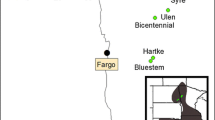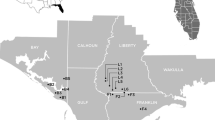Abstract
Genetic monitoring of reintroduced plantpopulations can allow assessment of the successin establishing new populations thatgenetically resemble native populations. Weused a PCR-based method (Intersimple SequenceRepeats) to quantify genetic variation in fourreintroduced populations of Abroniaumbellata ssp. breviflora, an annualforb native to the Pacific Coast that isstate-listed endangered in Oregon. Thereintroduced populations ranged in size from 18to 4,111 individuals in the year they weresampled. Genetic variation was also quantifiedin the natural population that served as theseed source for the reintroduction efforts. Atotal of 77 loci (bands) was observed using twoISSR primers, providing 65 polymorphic loci. Asignificant, positive regression was observedbetween the log of population size for the fivepopulations and genetic variation when measuredas percent polymorphic loci (P), expectedheterozygosity (He> ), and with adissimilarity index (1 − Sxy) based on bandsharing. Two of the reintroduced populationsmaintained approximately 90% of the geneticvariation we observed in the source population. Based on these results, we predict thatreintroduced populations of A. u. ssp.breviflora that have at least 1,000individuals should maintain 90% of the geneticvariation of the source population.
Similar content being viewed by others
References
Brown AHD, Briggs JD (1991) Sampling strategies for genetic variation in ex situ collections of endangered plant species. In: Genetics and Conservation of Rare Plants (eds. Falk DA, Holsinger KE), pp. 99–119. Oxford University Press, New York.
Bucci G, Vendramin GG, Lelli L, Vicario F (1997) Assessing the genetic divergence of Pinus leucodermis Ant. endangered populations: use of molecular markers for conservation purposes. Theor. Appl. Genet., 95, 1138–1146.
Cabin RJ, Mitchell RJ, Marshall DL (1998) Do surface plant and soil seed bank populations differ genetically? A multipopulational study of the desert mustard Lesquerella fendleri (Brassicacaea). Amer. J. Bot., 85, 1098–1109.
Cabin RJ (1996) Genetic comparisons of seed bank and seedling populations of a perennial desert mustard, Lesquerella fendleri. Evol., 50, 1830–1841.
Ellstrand NC, Elam DR (1993) Population genetic consequences of small population size: implications for plant conservation. Ann. Rev. Ecol. Syst., 24, 217–242.
Esselman EJ, Jianqiang L, Crawford DJ, Winduss JL, Wolfe AD (1999) Clonal diversity in the rare Calamagrostis porteri ssp. insperata (Poaceae): comparative results for allozymes and random amplified polymorphic DNA (RAPD) and inter simple sequence repeat (ISSR) markers. Mol. Ecol., 8, 443–451.
Fitzsimmons NN, Buskirk SW, Smith MH (1997) Genetic changes in reintroduced rocky mountain bighorn sheep populations. J. Wildl. Manage., 61, 863–872.
Forbes SH, Boyd DK (1997) Genetic structure and migration in native and reintroduced Rocky Mountain wolf populations. Conserv. Biol., 11, 1226–1234.
Haig SM (1998) Molecular contributions to conservation. Ecol., 79, 413–425.
Helenurm K, Parsons LS (1997) Genetic variation and the reintroductions of Cordylanthus maritimus ssp. maritimus to Sweetwater Marsh, California. Restor. Ecol., 5, 236–244.
Hogbin PM, Peakall R (1999) Evaluation of the contribution of genetic research to the management of the endangered plant Zieria prostrata. Conserv. Biol., 13, 514–522.
Kaye TN (1995) Experimental reintroduction of the endangered pink sandverbena on Oregon beaches. Oregon Department of Agriculture, Salem, Oregon.
Kaye TN (1998) Experimental reintroductions of pink sand verbena at four sites on the Oregon Coast: Coos Bay, New River, Tahkenitch, and Siltcoos. Oregon Department of Agriculture, Salem, Oregon.
Kaye TN, Amsberry K, Gisler SD, Meinke, RJ (1998) Back from the brink: the challenges of endangered plant re-introduction. Hortus West, 9, 4–9, 90–91.
Kaye TN, Kirkland M, Testa N (1999) Growing endangered plants to save them: germinating, propagating and restoring pink sand verbena. In: Native Plants: Propagating and Planting (eds. Rose R, Haase D), pp. 100–107. Forest Research Lab, Oregon State University, Corvallis.
Knapp EE, Dyer AR (1998) When do genetic considerations require special approaches to ecological restoration?, In: Conservation Biology (eds. Fiedler PL, Kareiva PM), pp. 345–363. Chapman & Hall, New York.
Lynch M (1990) The similarity index and DNA fingerprinting. Mol. Biol. Evol., 7, 478–484.
Lynch M, Milligan BG (1994) Analysis of population genetic structure with RAPD markers. Mol. Ecol., 3, 91–99.
McCue KA, Holtsford TP (1998) Seed bank influences on genetic diversity in the rare annual Clarkia springvillensis (Onagraceae). Amer. J. Bot., 85, 30–36.
McGlaughlin M (1999) The Conservation Genetics of the Pink Sand Verbena, Abronia Umbellata ssp. Breviflora (Nyctaginaceae). BA thesis, Reed College, Portland, OR.
Miller (1997) Tools For Population Genetic Analysis, version 1.3. [http://www.public.asu.edu/~mmille8/tfpga.htm]
Mistretta O (1994) Genetics of species re-introductions: applications of genetic analysis. Biodivers. Conserv., 3, 184–190.
Montalvo AM, Williams SL, Rice KJ, Buchmann SL, Cory C, Handel SN, Nabhan GP, Primack R, Robichaux RH (1997) Restoration biology: a population biology perspective. Restor. Ecol., 5, 277–290.
Nagaoka T, Ogihara Y (1997) Applicability of inter-simple sequence repeat polymorphism in wheat for use as DNA markers in comparison to RFLP and RAPD markers. Theor. Appl. Genet., 94, 597–602.
Negro JJ, Torres MJ (1999) Genetic variability and differentiation of two bearded vulture Gypatus barbatus populations and implications for reintroduction projects. Biol. Conserv., 87, 249–254.
Nei M (1972) Estimation of average heterozygosity and genetic distance from a small number of individuals. Genetics, 89, 583–590.
O'Brien SJ (1994) A role for molecular genetics in biological conservation. Proc. Nat. Acad. Sci USA, 91, 5748–5755.
Oregon Natural Heritage Program (1998) Rare, threatened and endangered plants and animals of Oregon. Oregon Natural Heritage Program, Portland, OR.
Pavlik BM (1996) Defining and measuring success. In: Restoring Diversity: Strategies for the Reintroduction of Endangered Plants (eds. Falk DA, Millar CI, Olwell M), pp. 127–155. Island Press, Washington, D.C.
Pavlik BM, Nickrent DL, Howald AM (1993) The recovery of an endangered plant. I. Creating new populations of Amsinckia grandiflora. Conserv. Biol., 7, 510–526.
Peakall R, Smouse PE, Huff DR (1995) Evolutionary implications of allozyme and RAPD variation in diploid populations of dioecious buffalograss Buchloe dactyloides. Mol. Ecol., 4, 135–147.
Rhodes OE Jr., Buford DJ, Miller MS, Lutz RS (1995) Genetic structure of reintroduced Rio Grande wild turkeys in Kansas. J.Wild. Manage., 59, 771–775.
Schaal BA, Leverich WJ, Rogstad SH (1991) A comparison of methods for assessing genetic variation in plant conservation biology. In: Genetics and Conservation of Rare Plants (eds. Falk DA, Holsinger KE), pp. 123–134. Oxford University Press, New York.
Schemske DW, Husband BC, Ruckelhaus MH, Goodwillie C, Parker IM, Bishop JG (1994) Evaluating approaches to the conservation of rare and endangered plants. Ecol., 75, 584–606.
Scribner KT, Stuewe M (1994) Genetic relationships among Alpine ibex Capra ibex populations re-established from a common ancestral source. Biol. Conserv., 69, 137–143.
Smith TB, Wayne RK (1996) Molecular Genetic Approaches in Conservation. Oxford Univ. Press, New York.
Stuewe M, Scribner KT (1989) Low genetic variability in reintroduced alpine ibex (Capra ibex ibex) populations. J. Mammol., 70, 370–373.
Swensen SM, Allan GJ, Howe M, Elisens WJ, Junak SA, Rieseberg LH (1995) Genetic analysis of the endangered island endemic Malacothamnus fasciculatus (Nutt.) Greene var. nesioticus (Rob.) Kearn. (Malvaceae). Conserv. Biol., 9, 404–415.
Tillett SS (1967) The maritime species of Abronia (Nyctaginaceae). Brittonia, 19, 299–327.
Williams SL, Davis CA (1996) Population genetic analyses of transplanted eelgrass (Zostera maritima) beds reveal reduced genetic diversity in southern California. Restor. Ecol., 4, 163–180.
Williams SL, Orth RJ (1998) Genetic diversity and structure of natural and transplanted eelgrass populations in the Chesapeake and Chincoteague Bays. Estuaries, 21, 118–128.
Williamson PS, Werth CR (1999) Levels and patterns of genetic variation in the endangered species Abronia macrocarpa (Nyctaginaceae). Amer. J. Bot., 86, 293–301.
Wolfe AD, Liston A (1998) Contributions of PCR-based methods to plant systematics and evolutionary biology. In: Molecular Systematics of Plants. II. DNA Sequencing (eds. Soltis DE, Soltis PS, Doyle JJ), pp. 43–86. Kluwer Academic Publishers, Boston.
Wolfe AD, Xiang Q, Kephart SR (1998a) Diploid hybrid speciation in Penstemon (Scrophulariaceae). Proc. Nat. Acad. Sci USA, 95, 5112–5115.
Wolfe AD, Xiang Q, Kephart SR (1998b) Assessing hybridization in natural populations of Penstemon (Scrophulariaceae) using hypervariable intersimple sequence repeat (ISSR) bands. Mol. Ecol., 7, 1107–1125.
Zhivotovsky LA (1999) Estimating population structure in diploids with multilocus dominant DNA markers. Mol. Ecol., 8, 907–913.
Author information
Authors and Affiliations
Corresponding author
Rights and permissions
About this article
Cite this article
McGlaughlin, M., Karoly, K. & Kaye, T. Genetic variation and its relationship to population size in reintroduced populations of pink sand verbena, Abronia umbellata subsp. breviflora (Nyctaginaceae). Conservation Genetics 3, 411–420 (2002). https://doi.org/10.1023/A:1020507416654
Issue Date:
DOI: https://doi.org/10.1023/A:1020507416654




